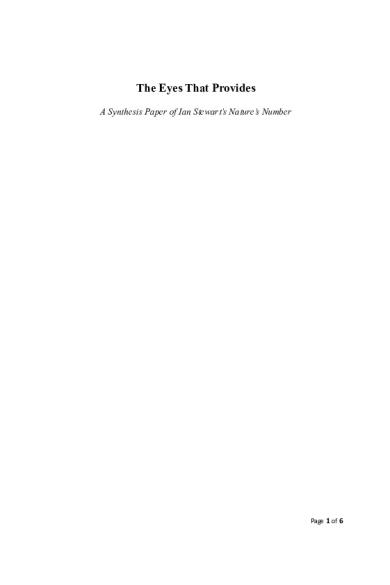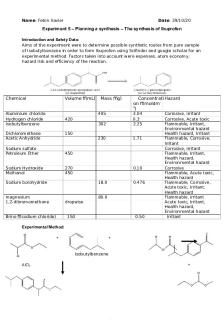Synthesis Paper of Ian Stewart’s Nature’s Number Mathematics PDF

| Title | Synthesis Paper of Ian Stewart’s Nature’s Number Mathematics |
|---|---|
| Course | BSBA Marketing Management |
| Institution | Batangas State University |
| Pages | 6 |
| File Size | 169.9 KB |
| File Type | |
| Total Downloads | 92 |
| Total Views | 413 |
Summary
A synthesis paper about the Nature's Number Mathematics...
Description
The Eyes That Provides A Synthesis Paper of Ian Stewart’s Nature’s Number
Page 1 of 6
Mathematics is one of the ideals that is convenient enough to make our lives comfortable and mindless. It played the big role in shaping the world into its advancements today. But, there are some common questions that the public is asking. Usually, they tend to ask, “Do I need Mathematics while working on the household chores?” or, “Do I need to calculate the formula before buying products?”. It may sound so absorb and seemed sarcastic but it’s a meaningful one. They all come back to one specific question: Does Mathematics works in every little thing that we do? Does the deepest insights of the Mathematician’s eyes about Mathematical statistics reliable to the world? Some may agree but few may not. However, is it possible that at the starting point, Mathematics came up with the coverage and maintenance in every field that is suitable for all of us? Can the Mathematician’s eyes really provides learnings in which we, human beings, may make use of it in our daily lives? And, does Mathematics puts into actions all the developed rules and structures, alongside the understanding of nature? Mathematics is worth more than what we knew about it. It is like wrapping our head around something. And, that something is Mathematics. It has proven to be challenging to some people but is greatly depends on an individual (Benecerraf, P. 1991). To begin with, Nature’s Numbers written by Ian Stewart, leads us to fully appreciate and understand Mathematics in an easier and interesting way. He commence with seeing the nature on a regular basis in which it will become a helping hand not only to students but also to other mankind to view the natural world in mathematical way. To gather the attention of the children who thinks that mathematics is a dime of dozen. The Nature’s Numbers is a broad overview of the deepest insights in the world. Nature’s Numbers introduces readers to the beauty of nature as revealed by mathematics and the beauty of mathematics as revealed in nature. How can nature works on patterns. Its numeric and geometric forms and movements. The book begins off with an introduction of patterns that we can observe in nature. Numerical patterns, patterns of form, movements (translation, rotation, reflection) and shapes are so widespread in the nature that it is difficult not to notice them. Stripes on zebras and tigers, spots on leopards and hyenas, movement of stars across the sky,
Page 2 of 6
number of seeds in the head of a sunflower, the shape of a snowflake and even colored arcs of light adorn the sky in the form of rainbows all happen based on a pattern. Ian Stewart once said “Mathematics is the science of patterns, and nature exploits just about every pattern that there is.” Mathematics became the key to unlock the mystery behind the patterns that recur in nature from the smallest seashell to the leaves and branches of trees inland. Many people became curious about these naturally occurring patterns just like Peter S. Stevens in his lovely book Patterns in Nature. They became curious about these patterns but did not focus on the mathematical perspective unlike Ian Stewart did in his book Nature’s Numbers. Ian Stewart think of patterns as basically numerical patterns, geometric patterns, and movement patterns. Furthermore, does the deepest insights of Mathematician’s eyes about Mathematical Statistics reliable to the world? The answer is, YES. Mathematical reliability refers to a body of ideas, mathematical models, and methods directed toward the solution of problems in predicting, estimating, or optimizing the probability of survival, mean life, or, more generally, life distribution of components and systems. (Barlow & Proschan, 1996, pp. 119-161). The body of knowledge and practice known as mathematics is derived from the contributions of thinkers throughout the ages and across the globe. It gives us a way to understand patterns, to quantify relationships, and to predict the future. Math helps us understand the world — and we use the world to understand math. The world is interconnected. Everyday math shows these connections and possibilities. The earlier young learners can put these skills to practice, the more likely we will remain an innovation society and economy. From my point of view, humanity was in a very curious position as regards the Mathematical Statistics. The mathematicians were worrying about how to set up insights upon the natural world and mathematics. I think, Mathematicians are very
Page 3 of 6
unpredictable. They tend to ask the question “WHY?” Mathematical universe seems real enough when you’re in it, when you were seeing intellectual world view. To start with, mathematics came up with the coverage and maintenance in every field that is suitable for all of us. Many mathematical scientists and academic math departments have justifiably focused on core areas, and this is natural in the sense that no other community has a mandate to ensure that the core areas remain strong and robust. But it is essential that there be an easy flow of concepts, results, methods, and people across the entirety of the mathematical sciences. For that reason, it is essential that the mathematical sciences community actively embraces the broad community of researchers who contribute intellectually to the mathematical sciences, including people who are professionally associated with another discipline. Mathematics is universal in a sense that other fields of human thought are not. It finds useful applications in business, industry, music, historical scholarship, politics, sports, medicine, agriculture, engineering, and the social and natural sciences. The relationship between mathematics and the other fields of basic and applied science is especially strong. A central line of investigation in theoretical mathematics is identifying in each field of study a small set of basic ideas and rules from which all other interesting ideas and rules in that field can be logically deduced. Mathematicians, like other scientists, are particularly pleased when previously unrelated parts of mathematics are found to be derivable from one another, or from some more general theory. Part of the sense of beauty that many people have perceived in mathematics lies not in finding the greatest elaborateness or complexity but on the contrary, in finding the greatest economy and simplicity of representation and proof. As mathematics has progressed, more and more relationships have been found between parts of it that have been developed separately—for example, between the symbolic representations of algebra and the spatial representations of geometry. These crossconnections enable insights to be developed into the various parts; together, they strengthen belief in the correctness and underlying unity of the whole structure. In my own perspective, Mathematics helps us to do all these things, and often it is indispensable. Mathematics doesn’t just dealt with the numbers, it also helps other Page 4 of 6
fields in terms of problem solving, decision making, maintenance and experimentations. If we will look closely, we’ll realized how mathematics contributes on all ages and across the world. We’ll be able to apply math strategies to solve problems and develop and explain the use of a given math concept in the global sense. And we’ll be able to use the right math tools in the right situations, explain why a math model they chose is relevant. More importantly, we will be able to use mathematical knowledge and skills to make real-life impact. Secondly, Mathematician’s eyes provides learnings in which we, human beings, may make use of it in our daily lives. Mathematician’s instincts has done something for human culture. The discoveries, intellectual worldview and the beauty and unity of patterns. According to Johannes Kepler, The Six Cornered Snowflakes – Motion of Stars, “Nature’s patterns are not just there to be admired, they are vitals clues to the rule that govern natural processes.” I think, what he wanted to tell us is that there is so much beauty in nature’s clue. Mathematics is like telling us a story in which it gives us the benefit to live an easier and innovative life. Patterns are formal system of thoughts to systematize and organize ideas. It means, we are given an opportunity to make use of those patterns. Patterns possess forms and movements. It enables us to use the math to make contributions to the global community, and solve complex problems in a complex world. And without it, nothing makes sense. Last, but not the least, Mathematics puts into actions all the developed rules and structures, alongside the understanding of nature. The mathematical structures that underlie their solutions to problems are contrasted with the conventional activities that characterize school mathematics. Which means that the developed rules and structures are applicable whenever we try to formulate and experiments, engage ourselves in different situations and such. It serves as great assistance and proven helpful for a future solution. In conclusion, I am confident to say that everything that the mathematicians are doing manifest all aspects in our world. It doesn’t matter if it’s big or small, what matters is the value of that thing. It enables our mind to solve situations in many different ways. It doesn’t take years to be knowledgeable enough in Mathematics. It Page 5 of 6
just need time, effort and perseverance to understand the deepest insights of the mathematician’s eyes.
References https://www.nap.edu/read/15269/chapter/5 http://www.project2061.org/publications/sfaa/online/chap2.htm https://asiasociety.org/education/understanding-world-through-math https://journals.sagepub.com/doi/abs/10.3102/00028312027001029 Adam, J.A. (2011). Mathematics in Nature:Modeling Patterns in the Natural World. (Course Book ed.). Princeton: Princeton University Press. Barolow, R., Proschan, F. “Mathematical Theory of Reliability.” Classics in Applied Mathematics; 162-197, SIAM Publications Online, 1996,
Page 6 of 6...
Similar Free PDFs

Federalist paper number 10
- 1 Pages

Question Paper number 5
- 4 Pages

Question Paper number 2
- 4 Pages

Synthesis Paper 7
- 8 Pages

Synthesis Paper - Grade: A
- 9 Pages

Syllabus - ian
- 9 Pages

Mathematics paper 1 TZ1 HL
- 13 Pages

SYNTHESIS OF DIMETHYL ETHER
- 54 Pages

Synthesis of Isopentyl Acetate
- 4 Pages

Synthesis of Sudan-1
- 4 Pages

The synthesis of Ibuprofen
- 4 Pages

Synthesis of methyl orange
- 9 Pages
Popular Institutions
- Tinajero National High School - Annex
- Politeknik Caltex Riau
- Yokohama City University
- SGT University
- University of Al-Qadisiyah
- Divine Word College of Vigan
- Techniek College Rotterdam
- Universidade de Santiago
- Universiti Teknologi MARA Cawangan Johor Kampus Pasir Gudang
- Poltekkes Kemenkes Yogyakarta
- Baguio City National High School
- Colegio san marcos
- preparatoria uno
- Centro de Bachillerato Tecnológico Industrial y de Servicios No. 107
- Dalian Maritime University
- Quang Trung Secondary School
- Colegio Tecnológico en Informática
- Corporación Regional de Educación Superior
- Grupo CEDVA
- Dar Al Uloom University
- Centro de Estudios Preuniversitarios de la Universidad Nacional de Ingeniería
- 上智大学
- Aakash International School, Nuna Majara
- San Felipe Neri Catholic School
- Kang Chiao International School - New Taipei City
- Misamis Occidental National High School
- Institución Educativa Escuela Normal Juan Ladrilleros
- Kolehiyo ng Pantukan
- Batanes State College
- Instituto Continental
- Sekolah Menengah Kejuruan Kesehatan Kaltara (Tarakan)
- Colegio de La Inmaculada Concepcion - Cebu



